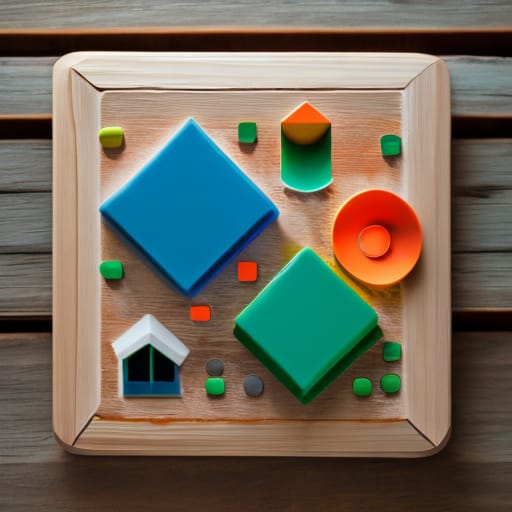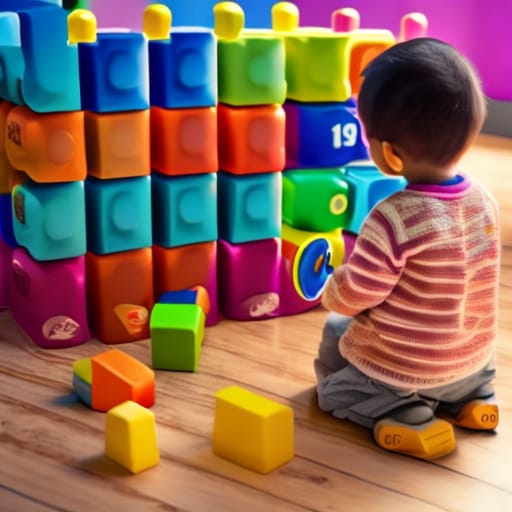Building blocks are some of the most versatile and educational toys for toddlers. Playing with blocks helps promote cognitive, motor, and social skills during important early development stages. With so many options to choose from, it can get overwhelming to pick the right block set for your 3 year old.
This ultimate guide covers everything you need to know about selecting the best building blocks for 3 year olds. We’ll explore the different types of blocks, top-rated sets, safety considerations, ways to play and learn with blocks, and eco-friendly options. Let’s get started!
Why Are Blocks So Important for Toddlers?
Playing with blocks offers numerous developmental benefits for toddlers:
- Cognitive skills – Blocks encourage imaginative, open-ended play. Tots plan, problem solve, and develop spatial reasoning as they explore concepts like cause and effect, symmetry, proportions and balance.
- Math concepts – Stacking, sorting and counting blocks helps reinforce numbers, shapes, colors, patterns and measurements.
- Motor skills – Building and knocking down structures promotes handeye coordination, fine motor dexterity and gross motor skills.
- Communication – Describing their creations and collaborating with others develops vocabulary and social skills.
- Self-confidence – Successfully completing block constructions boosts self-esteem and independence.
With all these perks, blocks are hands down one of the best educational toys for the key developmental window between ages 3-5 years.
Types of Building Blocks for Toddlers
There are several broad categories of blocks tailored to toddler play. Let’s compare the common characteristics of each.
Wooden Blocks
- Durable, versatile sets promote open-ended play
- Often made from renewable wood like birch, maple or beech
- May have round edges for safety
- Printed letters, numbers and patterns teach concepts
- Classic, attractive aesthetic
- Cost varies based on type of wood
Popular Brands: Melissa & Doug, Lovevery, Grimm’s, Haba
Plastic Blocks
- Offer bright colors to stimulate visual perception
- Lightweight for easy building and transport
- Can snap together with connectors
- Affordable price point
- Some sets may contain BPA and other chemicals
- Not as durable or eco-friendly as wood
Popular Brands: Lego, Mega Bloks, Fisher-Price
Foam & Soft Blocks
- Very lightweight, easy for small hands to manipulate
- Fabric covering provides tactile stimulation
- Foam construction safe for even babies
- Great for indoor and outdoor use
- Less durable over time
- Difficult to sanitize compared to hard blocks
Popular Brands: HABA, Edushape, Sassi, PlayShifu
Magnetic Blocks
- Allow for STEM and engineering explorations
- Satisfying sensory experience and bonding play
- Promote spatial reasoning and geometric design
- Can be pricey for larger high-quality sets
- Magnets may fall out with rough handling
- Supervision recommended to prevent magnet ingestion
Popular Brands: Magna-Tiles, PicassoTiles, Magformers, Playmags
Now let’s dive deeper into some of the top-rated building block sets for 3 year olds across these different types.

10 Best Building Block Sets for Toddlers
Wooden Blocks
- Grimm’s Large Rainbow Wooden Block Set
- 45 rainbow-colored beech wood blocks in 7 shapes
- FSC certified wood from sustainable forests
- Rounded edges help prevent injuries
- $75 from Grimm’s Toys
- Lovevery Block Set
- 40 easy-grip maple blocks in squares and rectangles
- Lovely natural wood aesthetic
- Part of award-winning play kit subscription
- $80 if purchased separately from Lovevery
Plastic Blocks
- Mega Bloks Big Building Bag
- 80 classic Mega Bloks in bright colors
- Compatible with other Mega Bloks sets
- Resealable storage bag included
- $20 on Amazon
- Play22 Magnetic Block Set
- 44 magnetic blocks stick together as you build
- Textured edges provide grip for little hands
- Colorful patterns help develop visual perception
- $37 from Play22
Foam & Fabric Blocks
- HABA Rainbow Soft Blocks
- 30 rainbow-colored soft blocks
- Machine-washable fabric covers
- Just the right size for small hands
- $35 from HABA USA
- Sassi Junior Jumbo Building Blocks
- 30 lightweight foam building bricks
- Fun embossed textures and bright colors
- Carry bag for easy transport
- $25 from Sassi
Magnetic Tiles
- PLAYMOBIL Magnetic Mosaics
- 60 magnetic building tiles including pentagons
- Combines with other PLAYMOBIL sets
- Portable plastic storage case
- $50 from PLAYMOBIL
- PicassoTiles Magnet 3D Transparent Building Block Set
- 100 colorful magnetic pieces
- Allows for light-up creations
- Compatible with similar magnetic tiles
- $37 from PicassoTiles
This selection covers top-rated block sets across different materials with budgets ranging from $20 to $80. Keep reading for tips on selecting blocks tailored to your child’s unique interests and developmental stage.
Key Features to Look For by Age
Block features to prioritize differ slightly based on your tot’s age and abilities.
For 2 Year Olds
Focus on:
- Basic shapes: sticks, cubes, rectangles, arches
- Safety: large parts, rounded edges
- Manipulation: lightweight, easy to grasp
- Variety: textures, colors, patterns
For 3 Year Olds
Focus on:
- Skill-building: interlocking, stacking, sorting
- More complex shapes: ramps, pillars, triangles
- Early math concepts: numbers, size relations
- Enhanced durability as motor skills improve
For 4 Year Olds
Focus on:
- Educational concepts: letters, spatial orientation
- Advanced constructions: bridges, enclosures
- Group play: collaborative building, sharing
- Pre-STEM skills: balance, symmetry
Keep these age considerations in mind as we explore more aspects of choosing the best building blocks.
Safety First: What to Look For
Since blocks are one of the first toys toddlers interact with independently, safety is paramount.
Size and Shape
The Consumer Product Safety Commission sets safety standards for children’s toys. Make sure any blocks have:
- No parts or pieces that can break off
- No sharp edges
- Size greater than 1.25 inches across for ages 1-3
Materials
Verify blocks are constructed from:
- Non-toxic, child-safe materials
- BPA-free plastics
- Water-based stains and dyes
- Sustainably sourced woods certified safe for kids
Also ensure any paints or decorations are lead and phthalate-free.
Warning Labels
Read all warning labels and manufacturer specifications for the recommended age range based on safety testing. Also supervise play to prevent potential choking hazards or improper use.
With basic safety checks complete, let’s move on to maximizing building block play for learning.
Get the Most Value from Building Block Play
The best blocks offer open-ended play opportunities. Without step-by-step instructions, toddlers are free to construct anything they imagine. Encourage this self-directed experimentation in whatever way engages your child’s curiosity.
You can also sprinkle in some learning activities to develop cognitive abilities along the way.
Games to Try
- Simple patterns – Have your tot replicate patterns like red/yellow/blue or circle/square/triangle. Start simple, adding complexity over time.
- Categorization – Sort blocks by color, shape, size, texture or weight. Identify group similarities and differences.
- Problem solving – Pose challenges like “build something taller than you” or “make an enclosure for your stuffed animal.” Support their efforts to construct solutions.
- Scaffolding – Constructing an initial foundation helps form connections between blocks. Let your tot add on elements to create their custom tower or structure.
- Sequential steps – Arrange blocks in a logical order to map out steps like first/next/last or before/after.
Interact verbally to encourage thinking and language skills during these activities, but take cues from your toddler’s engagement level while playing.

Eco-Conscious Building Block Options
As our toddlers build a better future, parents want safe products that also protect the planet. We identify some of the best environmentally-friendly blocks below:
Sustainable Materials – Seek out renewable sources like solid wood blocks or plant-based plastic derived from sugarcane or corn resin. These naturally biodegrade over time unlike conventional plastics.
Non-Toxic Production – Products certified “non-toxic” ensure safe, ethical processes from manufacture through packaging. Oeko-Tex, GOTS and Greenguard are trustworthy certifications to look for.
Some of our favorite sustainable blocks include:
- Maple Landmark Wooden Blocks – FSC-certified North American maple and non-toxic water-based finishes
- LitiHut Eco Blocks – Plant-based plastic made from sugarcane resin and bamboo fiber
- Edushape Rainbow Blocks – Foam made from recycling processes, fabric from natural rubber/cotton
While often costing a bit more upfront, environmentally-friendly blocks pay off through years of use and peace of mind about safety.
Final Takeaways on Building Blocks
We’ve covered a lot of key considerations for selecting the best building block toys for your 3 year old tot. Here are the essentials to remember:
- Blocks build cognitive, motor and social skills during toddler development
- Tailor block features like size, patterns and connectors to your child’s evolving abilities
- Verify safety standards and labels – supervise play for choking/fall hazards
- Encourage open-ended construction play to stimulate growing imaginations
- Supplement self-directed play with learning games using numbers, shapes and patterns
- Seek out sustainable blocks when possible – it’s a small step toward an eco-friendlier future!
With this knowledge in hand, we hope you feel equipped to pick building blocks your active toddler will love while also giving their growing mind a boost! Please share in the comments if you have questions or want personal recommendations. Happy building!
Frequently Asked Questions
What are the safest blocks for toddlers?
The safest toddler blocks are larger than 1.25 inches, have no small parts that can break off, feature rounded corners rather than sharp edges, and are made from non-toxic materials. Foam and fabric blocks often meet these safety criteria. Always supervise young children during block play.
What skills do blocks develop?
Playing with blocks builds a range of cognitive, social, emotional, fine motor and gross motor skills. Spatial awareness, mathematical concepts, hand-eye coordination, balance, problem-solving and creative expression all improve with open-ended block play.
What are the best blocks for 2 year olds?
The best blocks for 2 year olds feature simple shapes like cubes, rectangles and arches, bright colors and patterns to stimulate the senses, as well as varied textures and lightweight material for tiny hands to manipulate.
When should babies start playing with blocks?
Blocks help develop fine motor control and sensory exploration starting as early as 6 months old. Seek out soft blocks sized for an infant’s grasp and mouth exploration. Always supervise baby during block play due to choking hazards with small parts.
Are Megabloks better than Legos?
Both Lego and Mega Bloks offer quality interlocking plastic bricks but Mega Bloks wins when it comes to price and safety for toddlers. Mega Bloks bricks work out to about 10 cents each versus Lego’s 50 cent average price. Mega Bloks also offers larger pieces better suited for preschoolers.
